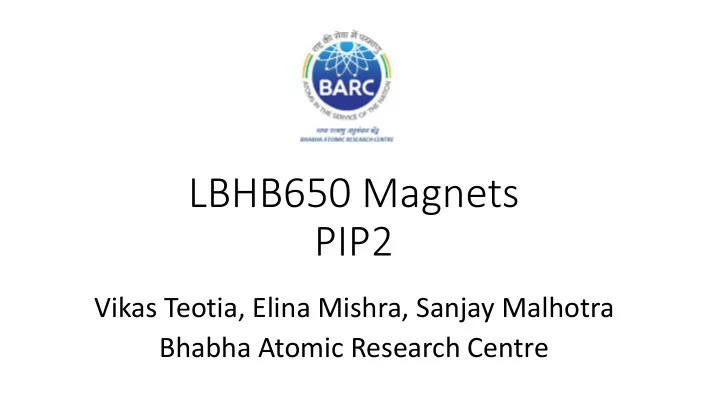

LBHB650 Magnets PIP2 Vikas Teotia, Elina Mishra, Sanjay Malhotra Bhabha Atomic Research Centre
Typical downstream Quadrupole Magnet
View from high energy end
View from low energy end
Top View Side view
Feedback from FNAL • For the dipole magnets: • 1. The peak field in the flux return area is relatively large 1.5-1.59 T (See Fig. 20), which is less than the expected 2.1 T saturation of the material. The review panel suggests increasing the dimension of the yoke cross section (either width or height) to reduce the flux to a magnitude less than 1.3 T. This dimensional increase would offset any potential variability of the steel material. If increasing in the beamline direction, then dimensional extents of the yoke may approach outer coil dimension, but maintain the 60 mm dimension near the beam pipe. BARC will consider making these changes. 1.5 T should be Ok as maximum limit • 2. The dipole has large harmonics (Fig. 19) which may be adjusted with pole profile tilt or pole end shims. The reviewers suggest incorporating this adjustment mechanism to minimize the harmonic effect with the quadrupole. The harmonics meet the TRS requirements. • For the quadrupole magnets: • 1. The tolerances of the pole tip dimensions and curvature profile are not specified to corroborate field map simulations. Detail drawings are necessary for confirmation (will be a recurring theme). • 2. Only 33 windings of the conductor are shown in Fig. 5. Specify where the potential 34th winding would be placed if needed to achieve field magnitude. Along the same lines, 43 windings are shown for the individual quadrant in Fig. 40 suggesting ambiguity about the final conductor winding count. Ambiguity is removed • 3. Similar saturation is occurring at the sharp corners of the pole (see Fig. 12). Including a radius to keep the maximum field below 1.3 T is necessary. • BARC will consider making these changes. 1.5 T should be Ok as maximum limit
Feedback from FNAL contd … • Electrical • The electrical conductors provided in the images interface with the vertically orientated lugs specified by Fermilab. The following features, however, are unclear and require specification: • 1. The positive/negative conductor spacing should have a minimum of 12.5 mm of separation in open air to prevent arc discharge. Ensured • 2. Conductive routing jumpers shown in Fig 41 appear to be in free space and not adequately attached to the steel pole material. Implemented • 3. Zinc plated steel bolts should be specified for good conductivity of copper- to-copper contacts. Implemented • 4. The ground clearance of the negative conductor lead in Fig 41 should be increased to prevent damage when the assembled quadrupole is placed on a non-level work surface. Implemented • 5. No terminal block for dipole electrical connection is shown in the models or 2D drawings. Implemented
Feedback from FNAL contd … Conductor-to-LCW • The manifold routes building supply low conductivity water (LCW) to the 4 conductor windings in parallel for uniform cooling. Interface features that should be specified prior to production: • Material of the manifold is ambiguous. The aluminum to copper connection should be avoided to prevent corrosion. There is no aluminum to copper connections. • Only general statement about “provisions for disconnecting the hydraulic circuit” is provided. Details of the electrically insulating connection to the manifold with individual in situ removal/replacement capability is needed. Included • What is the maximum side load that the manifold can withstand? If wrenching flats will be available for LCW building connection (as indicated in text), the feature is not shown in the models provided. Implemented
Feedback from FNAL contd … • Mechanical • External dimensions of the assembled magnets meet the constraint requirements. Statements indicate that mechanisms will exist to meet the needs of handling and positioning. However, the following features require specific callout: • Screws and other hardware are unspecified. Confirm that stainless steel-to-stainless steel connections will be avoided to prevent galling/cold welding that will hinder disassembly Confirmed • Locations for mounting lifting fixture eyebolts require specific locations on both dipoles (either horizontal or vertical direction) as well as separate top and bottom halves of the quadrupole magnets. Both top and bottom parts of the Quadrupole have lifting eye bolts, dipole too have eye bolts for lifting. Drawings will include them in more details. • Fiducial nest for metrology alignment are shown in some figures, but dimensional locations are absent. Provided • Alignment features to mate top-to-bottom of the quadrupole are absent. Detailed drawings of either bus bars or pin alignments are required. Implemented • Mounting of the magnets has some ambiguity: Support structures should have material specification that are non-ferromagnetic OK • Quadrupoles should call out drawing F10120694 as the interface. OK • Are mounting cleats in Fig. 16 acceptable? No agreement for dipole mounting interface is provided as a reference. Needs discussion
Thanks
Recommend
More recommend